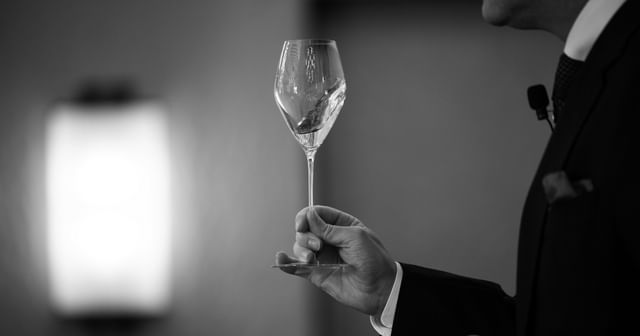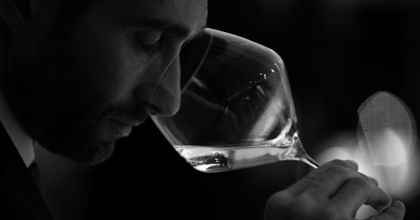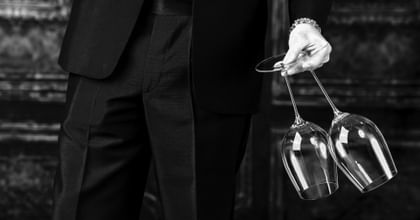A formal guide
The Stages of Wine Tasting

Keen to learn more about wine? Read our guide on how to critically assess wines.
Look of the wine
A faulty wine, such as one that is oxidized or cooked, will be noticeable through its incorrect color.
Pour a small amount of wine into a glass, tilt the glass at an angle of 45 degrees away from you and look at it against a plain white background.
To help you identify the color, take a look at the table of wine colors, or click here to learn about wine faults and how to identify them. In addition to color, you can also assess:
- Color Intensity: faint, subtle, light, medium, hazy, dense, dark, deep, opaque
- Clarity: intransparent, cloudy, translucent, hazy, slightly, transparent, clear, radiant, brilliant
- Liveliness: dead, lifeless, dull, flat, rich, active, vivid, lively, vibrant
- Perlage/Carbonic Acid: stale, flat, calm, beading, medium vivid, tingling, sparkling, fizzy, Hissing

Scent of the swirled wine
Gently swirl the wine in the glass with a rhythmic circular motion of your wrist. If you aren't confident doing this, place the glass's base on a flat surface like your table and, holding near the base, move the glass in a smooth circle to swirl the wine.
Swirling wine releases the less volatile aromas, allowing you to capture the complete picture of the nose of the wine. Take another deep smell; do you perceive any new aromas?
Taste of the wine
mouthfeel (how does it feel in your mouth?) and finish (what's your last impression, how long does it last?).
If you are tasting a series of wines, keep in mind that any consumed alcohol will impact your sense of taste.
Drink water to neutralize your palate between wines, as eating dry bread or crackers can affect your sense of taste.
Here is a good list of criteria to further assess the taste:
- Sweetness: bone-dry, dry, subtle, medium-dry, sweet, heavy, syrupy, honeyed, plump
- Acidity: hollow, thin, refreshing, lively, crisp, vigorous, tart, aggressive
- Tannins: silky, velvety, tender, rounded, fine-grained, raw, hard, coarse
- Astringency: subtle, smooth, mouth-filling, integrated, furry, coating, coarse, harsh, abrasive
- Bitterness: subtle, light, medium, firm, dominant
- Body: hollow, light, lean, round, powerful, muscular, voluptuous, fat, heavy
- Alcoholic Strength: watery, thin, light, balanced, warm, hot, vigorous, intense, spirity
- Consistency: diluted, light, medium, concentrated, rich, heavy, thick, pasty
- Aroma Intensity: faint, delicate, subtle, pronounced, concentrated, intense, exuberant, explosive
- Finish: abrupt, slight, short, medium, expanded, long, lingering, infinite
The wine as a whole
Complexity: dumb, dull, simple, straightforward, defined, layered, nuanced, complex, overwhelming
Balance: poor, unbalanced, incomplete, jagged, one-dimensional, centered, balanced, graceful, harmonious
Age: fresh, youthful, emergent, mature, advanced, declining, tired, finished, dead
If you're tasting wines with friends, you can make notes, score the wine using a 20 or 100 points scale, and compare your impressions with one another.
- 20 point scale: 20 classic, 19 extraordinary, 18 outstanding, 17 excellent, 16 very good, 15 good, 14 average, 13 bel. average, 12 poor, 11 unacceptable
- 100 point scale: 95 -100 world class, 90 - 94 outstanding, 85 - 89 very good, 80 - 84 good, 75 - 79 average, 70 - 74 below average, 65 - 69 banal, 60 - 64 acceptable, 55 - 59 defective, 50 - 54 unacceptable
Locations

